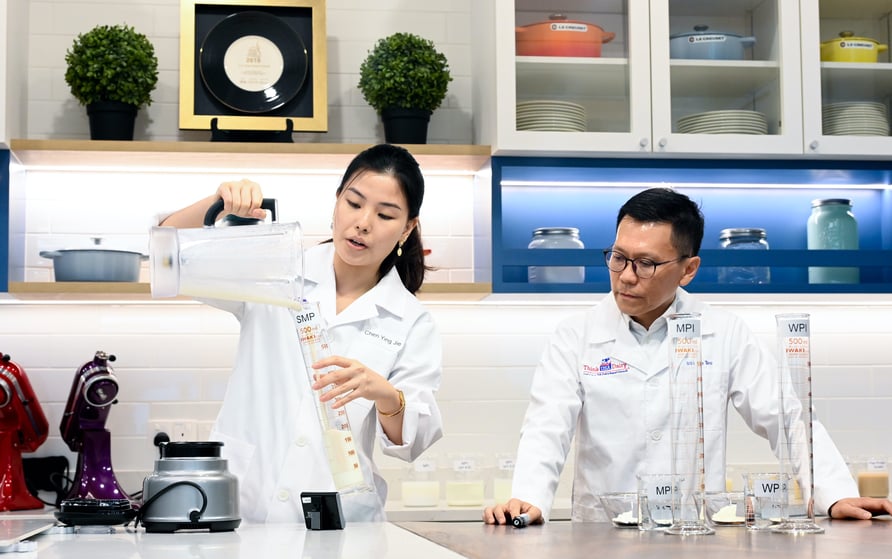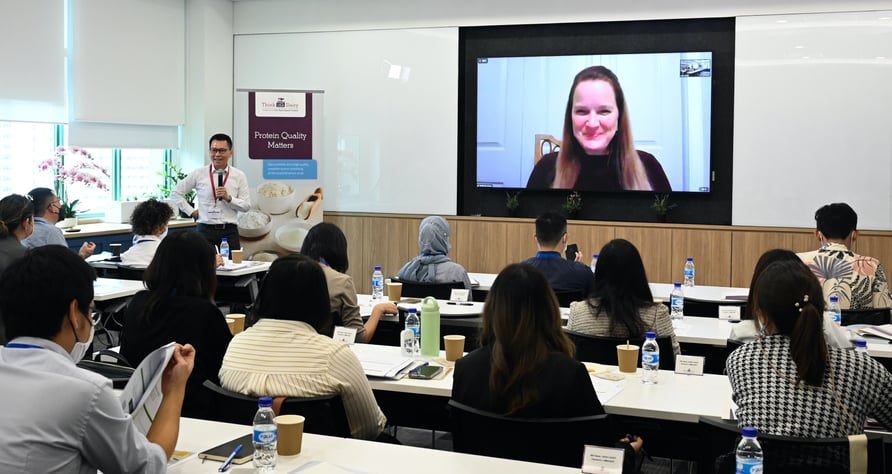HIGHLIGHTS: september 9, 2022
• USDEC-SRA memorandum of understanding
• July U.S. dairy export results
• U.S. CDE beverage workshop
• Market Summary: Southeast Asia helps lift GDT
• Senate committee advances McKalip nomination
• USDEC Export Guide gets 122 updates in August
• Ireland focuses on Asian dairy demand
Featured
USDEC signs MOU with Argentine ag group to promote sound science
USDEC and NMPF formalized a Memorandum of Understanding (MOU) with Argentine agricultural association Sociedad Rural Argentina (SRA) aimed at increasing collaboration on key issues that affect their memberships. The agreement spans two years and includes a strong focus on food policy priorities as well as Codex, sustainability and food systems issues. The groups plan to advocate for science-based regulations across food and agricultural trade policy.
“Together we will work to ensure international regulatory policy is based in science, while we also endeavor to reduce unnecessarily burdensome barriers to trade between our two nations,” said USDEC President and CEO Krysta Harden in a joint USDEC/NMPF press release on the agreement.

Left to right: Jaime Castaneda, USDEC Executive Vice President for Policy Development and Strategy; Nicolás Pino, President of the SRA; and Nick Gardner, USDEC Senior Vice President, Sustainability and Multilateral Affairs, after the signing of the MOU in Argentina.
The MOU’s focus on collaboration to address global issues impacting dairy and dairy trade aligns with similar MOUs USDEC and NMPF signed with the Inter-American Institute for Cooperation on Agriculture (IICA) and the Pan American Dairy Federation (FEPALE) (see Global Dairy eBrief, 4/8/22, for more on USDEC’s expanded MOU with IICA signed earlier this year). USDEC has worked closely with IICA and FEPALE on numerous issues over the past few years, from Codex standards to World Health Organization policies to the UN Food Systems Summit.
All three agreements provide USDEC and NMPF with an additional avenue to communicate and engage with stakeholders in Latin America.
U.S. dairy exports rise 5% in July
Year-over-year U.S. dairy export rose 5% in July in terms of milk solids equivalent (MSE). Since a 1% decline in March, volume has grown for four straight months. Year to date through July, U.S. export volume was up 3%, compared to the previous year.
July export value rose 25% to $831 million, putting year-to-date U.S. export value at $5.631 billion—a 27% increase over January-July 2021. To put the size of that year-to-date number into context, U.S. dairy export value for the entire 12 months of 2018 was $5.583 billion.
Whey and lactose lead
While most major product sectors posted year-over-year gains in July, whey and lactose had some of the most impressive growth.
Year-over-year U.S. whey exports jumped 13% in July (+7,028 MT), the third straight monthly gain. Improvement at West Coast ports, the moderation of U.S. dry whey prices and the recovery of China’s pig sector have helped lift demand across all geographies. China led U.S. buying in July, with year-over-year volume up 13% (+3,118 MT). But U.S. suppliers saw widespread whey export gains: Southeast Asia +22% (+2,225 MT); Canada +51% (+1,685 MT); South America +123% (+1,307 MT); and Japan +47% (+860 MT).
Lactose exports jumped 22% (+7,129 MT) in July with strong growth to China (+48%, +3,326 MT) and New Zealand (+78%, +2,419 MT).
But volumes also rose for:
- Cheese +2% (+602 MT), led by the Middle East/North Africa (+86%, +1,379 MT) and Mexico (+17%, +1,686 MT).
- Butter +78% (+2,661 MT), with Bahrain (+168%, +1,304 MT) recording the biggest gain.
- MPC +31% (+1,172 MT), led by Southeast Asia (+366%, +992 MT).
- Fluid milk +7% (+910 KL), with increased shipments to Taiwan (+22%, +1,325 KL).
Milk powder still lagging
Year-over-year NFDM/SMP exports fell 10% to 64,792 MT (-6,967 MT), held back in large part by tight U.S. supply. Year-to-date U.S. NFDM/SMP production is down 9% (-67,540 MT) year to date through July.
A 7% increase in shipments to Southeast Asia (+1,416 MT) and a 74% gain to Central America (+1,054 MT) weren’t enough to offset declines to Mexico (-14%, -4,092 MT), the Middle East/North Africa (-66%, -2,238 MT), and China (-20%, -1,391 MT).
For a deeper dive into the data, read the U.S. Dairy Export Blog story, “July export gain runs growth streak to four straight months.” Also visit the U.S. Exports tab at the USDEC Data Hub and experiment with the interactive charts.
Events
U.S. CDE: actions continue with beverage workshop
Since “living-with-COVID” became the standard approach to the pandemic in most countries outside of China, in-person overseas USDEC marketing activities have been picking up pace. That is particularly true at the U.S. Center for Dairy Excellence (U.S. CDE) in Singapore.
Twenty-one representatives from Southeast Asian beverage makers—primarily R&D personnel—attended the two-day innovation workshop at the U.S. CDE on Aug. 24-25. “Powering Beverages with U.S. Dairy Proteins” was the second major in-person customer event at the U.S. CDE in as many months (see Global Dairy eBrief, 7/29/22, for information on the dairy protein and permeate workshop).
The workshop drew participants from Indonesia, Malaysia, the Philippines, Singapore and Thailand. Its aim was to demonstrate how U.S. dairy protein ingredients could be used to create new and innovative beverage products geared to the tastes, nutritional needs and packaging preferences of Southeast Asian consumers.
Three USDEC members presented at the event, which also included a product showcase, ingredient demonstrations and tastings in the U.S. CDE demo kitchen.

Left to right: Chen Ying Jie, technical director at Consumer Centric Innovation (a Singapore-based consultancy that supports USDEC with technical and innovation projects), and USDEC’s Martin Teo in the U.S. CDE’s demo kitchen conducting an experiment to demonstrate U.S. dairy ingredient functionality to the beverage workshop attendees.

Attendees sampled product prototypes developed through USDEC’s partnership with Singapore Polytechnic’s Food Innovation and Resource Centre. Left to right: Pomelo-flavored Protein Water made with U.S. WPI and featuring coconut gel pieces for a textured bite; Honey Ginger Milky Protein beverage featuring U.S. MPC85; Sparkling Honey Lemon Protein Water made with U.S. WPI.
Over the course of two days, workshop participants heard from an expert lineup of innovation professionals, headlined by product formulation expert and USDEC consultant Melinda Moss. Moss discussed how to select and utilize the best dairy protein ingredient based on the beverage system being used and addressed a range of functionality and performance considerations, from mouthfeel to hydration to pH stability.

USDEC consultant Melinda Moss (on screen) addresses workshop attendees at the U.S. CDE along with USDEC’s Martin Teo (standing, left). Moss previously lived in Singapore and has years of experience working with customers in the region to customize products and processes to meet manufacturers’ and consumers’ needs.
Three USDEC members also spoke to the workshop participants, and the event included a 1.5-hour session at Glanbia Nutritionals’ Collaboration Center in Singapore. Three USDEC Southeast Asia office representatives rounded out the lineup:
- Shahirah Mustafa, program director, gave a presentation titled, “Why U.S. Dairy and U.S. Dairy Sustainability.”
- Anoo Pothen, director of consumer insights spoke on “Trends and Opportunities for Protein Beverages in Southeast Asia.”
- Martin Teo, technical director – food applications outlined “Southeast Asia-Friendly Protein Beverage Innovations.”
The workshop concluded with an ideation exercise. Attendees broke into groups for new beverage innovation brainstorming sessions using the knowledge they had gained on U.S. dairy ingredients over the course of the two days.
Additional end-user outreach
USDEC also engaged with Southeast Asian food processors this week through a cover story in the regional trade publication Asia Pacific Food Ingredients (APFI). The piece, featuring information and several quotes from Teo, highlights ways in which Southeast Asian snack manufacturers can use U.S. dairy ingredients (dairy proteins and permeate, specifically) to meet consumer demands for good tasting snacks that also yield nutritional benefits.
To help guide regional snack makers in product development, it also features findings from custom USDEC research conducted last year into regional consumer attitudes on “healthier” snacking and what shoppers look for from a nutrition standpoint when reading a product label.
“Better-for-you snacks became mainstream a few years before COVID-19, but the pandemic moved it into high gear as more people are snacking throughout the day as their new norm,” said Teo.
First of three Asian food ingredient shows
Additionally, Teo and several other USDEC Southeast Asia office representatives were in Indonesia this week participating in the Food Ingredients (Fi) Asia trade show that took place Sept. 7-9 in Jakarta. It is the first in-person trade show for USDEC ingredients programs in Southeast Asia since the fall of 2019, and also the first of three Fi shows in Asia in which USDEC is exhibiting over the next five weeks. Further information on show activities and how staff worked to spark local-friendly ideation and innovation with U.S. dairy ingredients will be shared in October following conclusion of subsequent shows in Bangkok and Ho Chi Minh City.
Market Summary
Southeast Asian appetite helps lift GDT
The Global Dairy Trade (GDT) Price Index recorded its best gain since March (and only its second increase in the last 11 auctions), rising 4.9% at this week’s event. Strong demand from Southeast Asia—a recurring theme this year—and solid buying levels from other regions on select commodities fueled the increase.
Compared to the same auction in 2021, Southeast Asia increased purchasing across all major product categories. The Middle East increased WMP and butterfat purchasing compared to the previous auction, as well as the same auction the previous year. Africa bought more cheddar and the EU lifted milk powder and butter purchasing vs. the previous auction.
Global supply remains tight. And after six months of mostly declining prices on the GDT and continued supply uncertainty ahead, buyers took the opportunity to refill pipelines even though prices remain elevated compared to historical levels.
Chinese appetite tepid
North Asia (China) remained the outlier at this week’s auction with ongoing muted demand. Apart from buying the largest volume of butter at the auction and increasing SMP purchasing, China continues to undershoot expectations. Extreme weather, COVID lockdowns and significant questions about its domestic economy continue to undercut consumption. Chinese WMP stockpiles aren’t helping either. The country reportedly held just under 200,000 MT at the end of July.
Price changes
AMF led all gains as the average winning price spiked 13.9% to US$5,677/MT. WMP rose 5.1% to US$3,610MT. It was the first price increase for both products since the June 7 auction.
SMP rose 1.5% to US$3,575/MT. After significant declines from June 21-Aug. 2, SMP appears to have found a floor.
Butter gained 3.3% to US$5,369/MT and cheddar rose 1% to US$5,46/MT. Cheddar prices have settled in a price band between US$4,798/MT and US$5,046/MT for six consecutive auctions.
Trade Policy
Senate committee approves McKalip; USDEC urges full Senate vote
USDEC applauded the Senate Finance Committee’s decision to advance Doug McKalip as the new Chief Agricultural Negotiator at the Office of the U.S. Trade Representative (USTR)—and urged the full Senate for a swift confirmation vote.
USDEC President and CEO Krysta Harden commended the committee’s decision in a joint USDEC/NMPF press release citing McKalip’s experience and understanding of the needs of the U.S. dairy industry, agricultural workers and the rural economy.
“Now, we ask the full Senate to take up the matter and approve McKalip’s nomination in the coming few weeks,” she said. “Time is of the essence, as USTR considers a broad range of new trade endeavors.”
USDEC has been strongly urging the Biden Administration and Congress to fill the critical trade role of chief agricultural negotiator position since the president took office, most recently co-signing an ag coalition letter to the Senate Committee on Finance to advance the nomination (see Global Dairy eBrief, 7/15/22).
Market Access & Regulatory Affairs
USDEC updates 122 Export Guide documents in August
Change was in the air in importing countries for dairy trade rules and regulations in August. USDEC’s Market Access and Regulatory Affairs (MARA) team updated or revised a whopping 122 documents in the USDEC Export Guide last month. Changes include:
Volume 1: Tariffs and Classification
- Bahamas: Noted decreased VAT and elimination of cheese tariffs.
- Malaysia: Updated whey tariff codes of HS 0404.10; added sugar-related excise duty applicable to beverages of Chapter 22.
Volume 2: Import Requirements
- APHIS certificates: Added new application submission procedures and contact points for all Midwestern states, including Illinois, Indiana, Iowa, Kentucky, Michigan, Minnesota, North Dakota, Ohio, South Dakota, and Wisconsin.
- Egypt: 1) Added detail from Egypt’s recent WTO amendment notification on new halal requirements, which is set for implementation on Oct. 1, 2022. 2) Updated “Product Registration/Approval” to reflect that milk and milk products intended for retail do not require registration. Also updated dietary foods registration information. 3) In “Legalization of Documents,” noted that legalization may not be required.
- India: Acknowledged India’s WTO notification of a new certificate template. The U.S. government is currently reviewing the new language.
Volume 3: Compositional Standards and Labeling
- Canada: 1) Updated compositional standards to reflect the maximum levels for contaminants. 2) Acknowledged Canada’s new front-of-package (FOP) labeling regulations published in July. MARA is incorporating the new specifications into the Export Guide, but in the meantime, USDEC members can also find more information here at the Government of Canada website.
- Chile: Updated Milk Powder and Fluid Milk standards to indicate vitamin D3 (cholecalciferol) fortification requirement.
- China: Updated standards for contaminants, processed cheese and cheese products, condensed dairy products, and beverages.
- Egypt: Added halal labeling requirements related to the entry into force of Egypt’s halal law on Oct. 1, 2022.
Every month, USDEC’s Market Access team emails a list of guide updates to interested members. If there is anyone at your company who should be included on the distribution list for that email in the future, please contact Jessica Smith at jsmith@usdec.org.
Company News
Ireland launches Asian dairy export campaign
Bord Bia, Ireland’s state agency tasked with promoting ag exports, launched a €3.2 million (about US$3.2 million since euro currently near parity with U.S. dollar) promotional campaign to boost Irish dairy exports in Japan, Malaysia, the Philippines, Thailand and Vietnam. The program kicked off last week with special technical seminars in Tokyo.
Bord Bia plans to target 10,000 Asian food and beverage company buyers through the campaign, which will include visits by Asian buyers and media to Irish dairy farms and processing operations. The group says it expects the effort to lift Irish dairy exports to the targeted group of countries by nearly €19 million. (Agriland, 9/1/22)
Company news briefs
Fonterra Co-operative Group opened its upgraded dairy foodservice application center in Beijing. It operates four such centers in China in Beijing, Chengdu, Guangzhou and Shanghai where it develops recipes for customers in all distribution channels using Fonterra ingredients and dairy products. … Mexican restaurant operator Alsea plans to open 200 new Starbucks stores in Mexico by 2026. … UAE dairy processor Al Ain Farms is partnering with ecommerce site DUBUY.com to market its dairy products in the UAE and throughout the Middle East and Africa. … Philippine food and dairy company RFM Corp. earmarked 1.2 billion pesos (about US$21 million) to expand fluid milk operations and institutional business. (USDEC China office; USDEC Mexico office; USDEC Middle East/North Africa office; USDEC Southeast Asia office)
In Case You Missed It...
U.S. Dairy Exporter Blog
Market analysis, research and news subscribe here
USDEC Twitter feed
Follow us here.